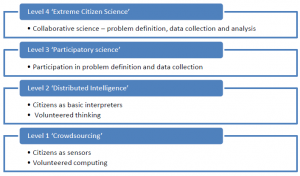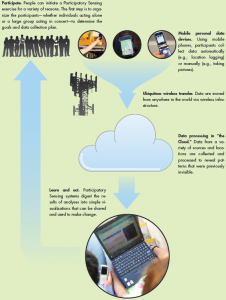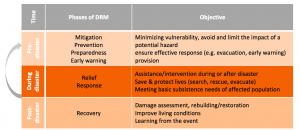What is social media and how it is used during and after disasters?
Nov 4th, 2014 by j0p
By David Max and Nicolás Gómez Armisén
Abstract
This text describes the idea, methods and use of social media during and after the event of a disaster. After defining what social media is and pointing out its advantages in disaster management we focus on its use during and right after a disaster. Our aim is to inform about the new possibilities for geographers derived from the use of social media during and after a disaster in order to create maps and process information via Web 2.0.
Introduction
Nowadays communication technologies allow a flow of information characterized by enormous speed, high magnitudes and a wide reach. People do not only receive information faster than ever but can use a broad range of media and sources to generate information in real-time (VIEWEG et al 2010). In other words, those technologies provide users with the ability to respond quickly to environmental changes and provide more flexibility, adaptability, usability and customizability with respect to both the system and the information (DAVES, Y & SCOTT, P, 2010, p. 3). Social media “supports the creation of informal users’ networks facilitating the flow of ideas and knowledge by allowing the efficient generation, dissemination, sharing and editing/refining of informational content” (CONSTANINIDES & FOUNTAIN, 2008, p. 231).
An example for the pre-named media are microblogging sites such as Twitter. Microblogging tools are present in a variety of platforms and facilitate immediate communication among people. It is part of a growing communication phenomenon - namely social media - and present in almost all parts of the world (VIEWEG et al 2010).
Social Media
KANE et al (2014) define social media networks by outpointing that they allow their members to “(1) have a unique user profile that is constructed by the user, by members of their network, and by the platform; (2) access digital content through, and protect it from, various search mechanisms provided by the platform; (3) articulate a list of other users with whom they share a relational connection; and (4) view and traverse their connections and those made by others on the platform“.
In line with Kane’s et al. definition, Dave, Y and Scott (2010) described social media as a tool that enables open online exchange of information through conversation and interaction. Unlike traditional internet and communication technologies (ICTs), social media manages the content of the conversation or interaction as an information artifact in the online environment. They add that, social media is part of a number of emerging technologies with the potential to improve flexibility, adaptability, and boundary spanning functionality demanded by response organizations for their information systems.
In view of the above we want do define social media as the international connection among people in virtual communities and networks in which they create, share or exchange any kind of information. Social Media has invented a big diversity of types. While some are used to spread news others connect people via Web 2.0 around the world. Data and posts (or microblogs) are available for everyone with internet access (STARBIRD, K et al 2010) . Social media platforms like Twitter evolve to a enormous network by connecting users with others. These networks are really effective not only in providing data but also in sharing specific information which can help during and after a disaster.
Twitter as tool
Social networking sites provide personal information of their users like name, location and other if the profile is public. Data is available for everyone with internet access (STARBIRD, K et al 2010). Social media platforms like Twitter (or platforms which copied the Twitter concept) evolve to an enormous network by connecting users with each other. Twitter, in particular, has a flexible communicative structure. It has two profile types, public (profile visible to all) and private (visible only for approved followers). Thanks to this feature, Twitter is more useful than Facebook which has a more complex visibility permission. The users can easily find and share hashtags related to the crisis event. (BRUNS and BURGESS, 2011).
The role played by social media in the coverage of natural disasters as well as in the mobilisation of affected locals and volunteers is increasingly being recognised (e.g., LIU, 2009; LIU, et al., 2008; Mark and SEMAAN, 2008; MENDOZA, et al., 2010; SHKLOVSKI, et al., 2008; SUTTON, et al., 2008).
There exist various types of methods for analysing the Tweets. Bruns and Burgess (2011), for example, describe and explain one method for the tracking and analysing hashtag–based Twitter activities which built on the open source tool “yourTwapperkeeper” (2011) and uses a number of additional tools to process and visualise Twitter activities.
During
The best way to explain how social media can help during a disaster is to make use of an example. That is what most authors do in their papers as in the following papers (AHMED, ASHIR; SINNAPPAN, SUKU, 2013; YATES, DAVE; PAQUETTE, SCOTT, 2011; VIEWEG, SARAH, et al, 2010).
Thanks to the features of the tool that we have already mentioned, users are able to produce large amount of information that can be extracted with different tools to check the status of disaster episode in which it is studied. Thanks to detailed descriptions including geographical information, posts can be used in order to determine the exact location and the status of the disaster.
The border between during and after of a disaster is hard to draw. We understand the end of a disaster as the moment in which it is controlled and post-disaster actions begin. We also classify disasters according to the duration. While earthquakes are normally of a short duration in the sense that vibrations only last a limited period, inundations have a more permanent character. Therefore, data describing the after in case of an earthquake is more important for disaster management.
The information created by Twitter user help to understand what is happening in an event with many actors and other moving parts, especially with respect to the needs of command and control operations (VIEWEG et al 2010). To use the data extracted from social media, it is important to be thorough in the process of validation and corroboration (GAO H., et al. 2011). Again, the use of tools, often created for each of the cases (BRUNS, A; LIANG, Y.E., 2012), will help in the task of identifying post that provide useful information in order to take actions during a disaster. Users can include geo-referenced information, which can be useful for organizations or institutions in order to create maps that can be used to plan actions of mitigation in the affected regions. The information on which the maps are based is derived from a geo-tag or directly expressed addresses or geo-referenced images of smart phones. (GAO, H., et al, 2011 & VIEWEG, S. et al, 2011.
During the disaster data is collected from emails, forms, tweets and other media networks and arranged in terms of emergency, needs, people injured and so on (GAO, H., et al. 2011). With the objective of knowing in what form action is required we can determine the location with the use of maps and geo-referenced information obtained. The aforementioned possible ways of dealing with the data produced in social media networks are extracted from concrete examples of data usage during real-life disasters analysed in various research articles.
Use after the disaster
Social media is used as an alternative communication channel during and after a disaster. Yet after such an event people in the affected region use social media in a different way. While information is posted on Twitter during a disaster mainly by affected people, Facebook is the platform which spreads the news about the disaster around the world (AHMED et al 2013). These posts on Facebook show to the rest of the world what happened and make them focus. Research shows that social media is an increasingly used possibility in Disaster Risk Management (DRM) and an effective way to get people’s attention.
Supporting people after the disaster is one thing social media can help with. Its actual power is, as already said, the speed and the huge amount of people who are connected. Such a network cannot just add, edit and change information. They can work as an early warning system using the crowd sourced data of the last disaster (GAO H., et al. 2011). As mentioned spreading news via Web2.0 is the fastest way to ensure that people worldwide or in a specific region receive important information. If there is a disaster coming up the social media networks can spread and share important information so people can prepare themselves on what is going to happen, where to find shelter and where to find help.
Conclusion
Social media is one of the most important ways people are able to communicate around the world in today’s time. Based on a web 2.0 network it is able to share information faster and more effective than other media networks. In the last years its meaning got more and more important. Especially the use during and after disaster is an important point. Affected people can use social media networks like Twitter or Facebook to add, share and edit information which can be used as support for other affected people or first helpers. Because it is a fact that there will be disasters in the future the significance of social media networks and its possibilities will grow. The questions now is: How can we improve the networks so they can work in a more effective way during and after a disaster.
KAPLAN, Andreas M.; HAENLEIN, Michael. Users of the world, unite! The chal lenges and opportunities of Social Media. Business horizons, 2010, 53.1: 59- 68.
AHMED, Ashir; SINNAPPAN, Suku. The role of Social media during Queensland floods: An Empirical Investigation on the Existence of Multiple Communities of Practice (MCoPs). Pacific Asia Journal of the Association for Informationsytems, 2013, 5.2: 2.
YATES, Dave; PAQUETTE, Scott. Emergency knowledge management and social media technologies: A case study of the 2010 Haitian earthquake.International Journal of Information Management, 2011, 31.1: 6-13.
VIEWEG, Sarah, et al. Microblogging during two natural hazards events: what twitter may contribute to situational awareness. In: Proceedings of the SIGCHI Conference on Human Factors in Computing Systems. ACM, 2010. p.1079-1088.
GAO, Huiji, et al. Harnessing the crowdsourcing power of social media for disaster relief. ARIZONA STATE UNIV TEMPE, 2011.
LINDSAY, Bruce R. Social media and disasters: Current uses, future options, and policy considerations. Congressional Research Service, 2011.
MERCHANT, Raina M.; ELMER, Stacy; LURIE, Nicole. Integrating social media into emergency-preparedness efforts. New England Journal of Medicine, 2011, 365.4: 289-291.




